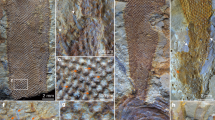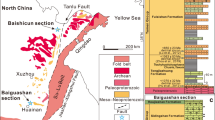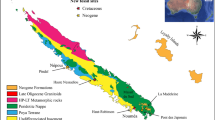Abstract
The Ediacara biota (~575–541 million years ago) mark the emergence of large, complex organisms in the palaeontological record, preluding the radiation of modern animal phyla. However, their phylogenetic relationships, even at the domain level, remain controversial. We report the discovery of molecular fossils from organically preserved specimens of Beltanelliformis, demonstrating that they represent large spherical colonies of cyanobacteria. The conservation of molecular remains in organically preserved Ediacaran organisms opens a new path for unravelling the natures of the Ediacara biota.
This is a preview of subscription content, access via your institution
Access options
Access Nature and 54 other Nature Portfolio journals
Get Nature+, our best-value online-access subscription
$29.99 / 30 days
cancel any time
Subscribe to this journal
Receive 12 digital issues and online access to articles
$119.00 per year
only $9.92 per issue
Buy this article
- Purchase on Springer Link
- Instant access to full article PDF
Prices may be subject to local taxes which are calculated during checkout

Similar content being viewed by others
References
Narbonne, G. M. & Hofmann, H. J. Palaeontology 30, 647–676 (1987).
Zaika Novatsky, V. & Palij, V. Paleontol. Sb. 11, 59–65 (1974).
Seilacher, A. J. Geol. Soc. 149, 607–613 (1992).
Leonov, M. V. Geol. Soc. Spec. Publ. 286, 259–267 (2007).
Gnilovskaya, M. B., Ishchenko, A. A., Kolesnikov, Ch. M., Korenchuk, L. V. & Udal'tsov, A. P. Vendotenidy Vostochno-Evropejskoj Platformy (Nauka, Leningrad, 1988).
Aseeva, E. A. in Biostratigraphy and Paleogeographic Reconstructions of the Precambrian of Ukraine (eds Ryabenko, V. A., Aseeva, E. A. & Furtes, V. V.) 81–92 (Naukova Dumka, Kiev, 1988).
Runnegar, B. & Fedonkin, M. in The Proterozoic Biosphere: A Multidisciplinary Study (eds Schopf, J. W. & Klein, C.) 369–388 (Cambridge Univ. Press, Cambridge, 1992).
Steiner, M. & Reitner, J. Geology 29, 1119–1122 (2001).
Steiner, M. Acta Univ. Carol. Geol. 40, 645–665 (1996).
Ivantsov, A. Y., Gritsenko, V. P., Konstantinenko, L. I. & Zakrevskaya, M. A. Paleontol. J. 48, 1415–1440 (2014).
Xiao, S. & Dong, L. in Neoproterozoic Geobiology and Paleobiology (eds Xiao, S. & Kaufman, A. J.) 57–90 (Springer Netherlands, Dordrecht, 2006).
Xiao, S., Yuan, X., Steiner, M. & Knoll, A. H. J. Paleontol. 76, 347–376 (2002).
Grazhdankin, D. Stratigr. Geol. Correl. 11, 313–331 (2003).
Kodner, R. B., Pearson, A., Summons, R. E. & Knoll, A. H. Geobiology 6, 411–420 (2008).
Alexander, R., Berwick, L. & Pierce, K. Org. Geochem. 42, 540–547 (2011).
Volkman, J. K. et al. Org. Geochem. 29, 1163–1179 (1998).
Allard, B. & Templier, J. Phytochemistry 57, 459–467 (2001).
Shaw, D. G. & Wiggs, J. N. Phytochemistry 18, 2025–2027 (1979).
Versteegh, G. J. M. & Blokker, P. Phycol. Res. 52, 325–339 (2004).
Ricci, J. N., Morton, R., Kulkarni, G., Summers, M. L. & Newman, D. K. Geobiology 15, 173–183 (2016).
Blumenberg, M. et al. Environ. Microbiol. 8, 1220–1227 (2006).
Nagovitsyn, A. in PALEOSTRAT-2015 (ed Alekseev, A. S.) 57–58 (PIN RAS, Moscow, 2015).
Jones, J. G. Microbiology 59, 145–152 (1969).
Gelpi, E., Oró, J., Schneider, H. J. & Bennett, E. O. Science 161, 700–701 (1968).
Matsumoto, G. I., Yamada, S., Ohtani, S., Broady, P. A. & Nagashima, H. Proc. NIPR Symp. Polar Biol. 9, 275–282 (1996).
Schouten, S. et al. Geochim. Cosmochim. Acta 62, 1397–1406 (1998).
Xiao, S. & Laflamme, M. Trends Ecol. Evol. 24, 31–40 (2009).
Acknowledgements
This study was funded by the Australian Research Council grants DP160100607 and DP170100556 (to J.J.B.). I.B. gratefully acknowledges an Australian Research Council Research Training Program scholarship. The authors are grateful to E. Luzhnaya, A. Nagovitsyn, M. Luzhnaya, P. Rychkov and V. Rychkov for help in the field, L. Zaytseva and E. Luzhnaya for scanning electron microscope imaging of organic matter, and J. K. Volkman, S. Xiao, N. J. Butterfield and R. E. Summons for helpful comments on an earlier version of the manuscript.
Author information
Authors and Affiliations
Contributions
I.B. conceived the study and performed the analyses. I.B. and A.K. collected the samples. J.M.H. helped with the methodology. A.I. provided palaeontological advice. I.B. and J.J.B. interpreted the results and wrote the paper.
Corresponding author
Ethics declarations
Competing interests
The authors declare no competing financial interests.
Additional information
Publisher’s note: Springer Nature remains neutral with regard to jurisdictional claims in published maps and institutional affiliations.
Supplementary information
Supplementary Information
Supplementary methods, information, references and figures
Supplementary Dataset
A numerical computation of the percentage of hopanes in the Beltanelliformis extract
Rights and permissions
About this article
Cite this article
Bobrovskiy, I., Hope, J.M., Krasnova, A. et al. Molecular fossils from organically preserved Ediacara biota reveal cyanobacterial origin for Beltanelliformis. Nat Ecol Evol 2, 437–440 (2018). https://doi.org/10.1038/s41559-017-0438-6
Received:
Accepted:
Published:
Issue Date:
DOI: https://doi.org/10.1038/s41559-017-0438-6
This article is cited by
-
Lipid biomarkers: molecular tools for illuminating the history of microbial life
Nature Reviews Microbiology (2022)
-
Food sources for the Ediacara biota communities
Nature Communications (2020)
-
Viewing the Ediacaran biota as a failed experiment is unhelpful
Nature Ecology & Evolution (2019)
-
Putative sponge biomarkers in unicellular Rhizaria question an early rise of animals
Nature Ecology & Evolution (2019)
-
Simple sediment rheology explains the Ediacara biota preservation
Nature Ecology & Evolution (2019)



